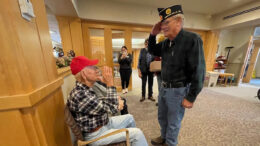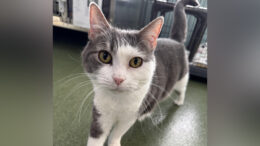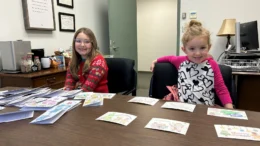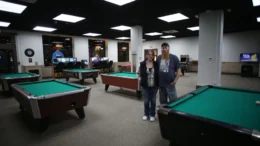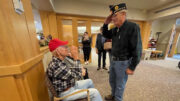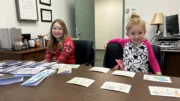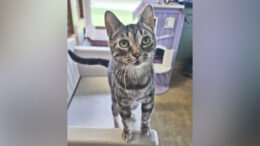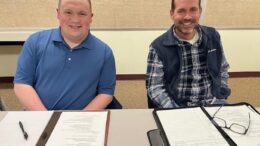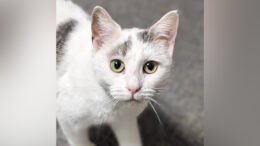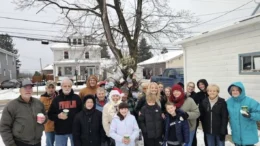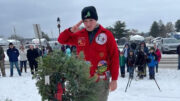HONOLULU (AP) — Trapped on a storm-battered boat in the middle of the Pacific Ocean for months, Jennifer Appel and Tasha Fuiava were just about out of food and beginning to believe they were completely out of luck when they finally saw it: a U.S. Navy ship chugging toward them.
“When I saw the gray ship on the horizon, I was just shaking,” Appel told reporters Friday. “I was ready to cry, I was so happy. I knew we were going to live.”
On Wednesday the pair, followed by their dogs, Zeus and Valentine, boarded the USS Ashland, all four looking remarkably fit for having been lost at sea for nearly six months.

In this Wednesday, Oct. 25, 2017 frame from video provided by the U.S. Navy, Jennifer Appel, left, and Tasha Fuiava, who with their dogs were rescued after being lost at sea for several months while trying to sail from Hawaii to Tahiti, are interviewed aboard the USS Ashland in the South Pacific Ocean. (AP)
They had been drifting aimlessly across the Pacific since the end of May and had sent out unanswered distress calls for 98 consecutive days before crew members aboard a passing Taiwanese fishing boat saw them on Tuesday and notified the Navy.
They had left Honolulu on May 3 aboard Appel’s 50-foot vessel the Sea Nymph for what was to be an 18-day journey to Tahiti, followed by months of leisurely cruising the South Pacific before returning home.
Disaster struck almost immediately when a storm battered their boat with 50- to 70-mile-per-hour winds for three days as they left Hawaii. They continued on anyway, thinking the vessel wasn’t that badly damaged.
By the end of the month another storm had flooded their boat’s engine, however, and they discovered its sails and mast had been damaged enough earlier that they could no longer generate adequate wind power to keep the vessel on course.
They were 900 miles off the coast of Japan, and thousands of miles in the wrong direction, when a Taiwanese fishing vessel found them and started to tow them.
As the fishing vessel was attempting to tow the Sea Nymph, the 100-ton steel ship was damaging the much smaller sailboat as it pulled it through the open ocean.
“We incurred incredible damage,” Appel said of the 24-hours under tow that were the scariest of the trip. It didn’t help that the women only spoke English, a language not spoken on the fishing vessel.
“We had a really tough time communicating with them that they were going to sink us within the next 24 hours,” she said.
Eventually she was able to swim to the fishing vessel and use their radio to make a mayday call.
The Navy ship showed up Wednesday, the next morning. When it just as quickly appeared to pass them by, they panicked momentarily once more.
“Ok, we’re going to make it,” Appel told herself after sailors radioed from the Ashland’s bridge assurances that they did indeed see them.
Their boat, deemed no longer seaworthy, was allowed to drift away after their rescue, although Appel says she hopes she might eventually retrieve and repair it.
She and Fuiava acknowledged that until the Navy arrived they began to wonder if they really would survive.
Appel credited their survival in part to the veteran sailors in Hawaii who had warned them to prepare well for their journey.
“They said pack every square inch of your boat with food, and if you think you need a month, pack six months, because you have no idea what could possibly happen out there,” Appel said. “And the sailors in Honolulu really gave us good advice. We’re here.”
They thought they had packed enough to last a year but with the six-month mark approaching they discovered they had gone through 90 percent of it. The dogs’ food had run out and they were sharing theirs with them.
“The dogs turned out to really like human food,” Appel said.
“A lot,” Fuiava added.
One of their water purifiers had also broken but they managed to fix it.
One night, a group of tiger sharks began attacking their vessel, and the next morning, a shark returned and rammed the boat again, Appel said. “We were just incredibly lucky that our hull was strong enough to withstand the onslaught,” she said in a video interview provided by the Navy.
Although Appel has been sailing the Hawaiian islands for 10 years and spent two years preparing for this voyage, she acknowledged she and Fuiava, a novice sailor, may not have prepared as well as they could have.
They said they tried without success to hail a number of ships and fired off 10 signal flares. One of their cellphones had been washed overboard early in the voyage, but they were out of cell range anyway.
They carried two GPS units; one failed and they had to rely on the hand-held model for the entire voyage, Appel said in a phone interview from the USS Ashland Friday.
They also had a new VHF radio, a ham radio, a weather satellite and a radio telephone. She says none worked, and they apparently had a communications failure with their new antenna.
She says they had six ways to communicate with multiple backups, and none of them worked. That, she said, “exceeds Murphy’s Law.”
They even carried a satellite phone that she said never seemed to connect.
The two women became fast friends a few years back when Appel was working on her boat and Fuiava was a security guard at the boat facility.
Appel invited her on the sailing adventure south of the equator.
“I’ve never been there, and I don’t know what’s going to happen,” Appel said. “She said, ‘OK, It sounds like an adventure.'”
Meanwhile, loved ones had no idea where they were. Appel’s mother said she contacted the Coast Guard when she hadn’t heard from her a week and a half into the voyage, and records show the Coast Guard put out a message on June 7 noting the vessel was missing.
As months passed and Appel’s mother heard nothing she said she never gave up hope.
“She is very resourceful and she’s curious, and as things break she tries to repair them,” Joyce Appel, 75, of Houston, said of her daughter. “She doesn’t sit and wait for the repairman to get there. “So I knew the same thing would be true of the boat.”
She finally got a call from her daughter early Thursday.
“She said, ‘Mom?’ and I said, ‘Jennifer!?’ because I hadn’t heard from her in like five months,” she said. “And she said, ‘Yes, Mom,’ and that was really exciting.”
Despite the ordeal, Appel says she’s far from done with the sea. If she can find and fix her boat she’ll be ready to take it out again.
“Well, you got to die sometime,” she said. “You may as well be doing something you enjoy when you’re doing it, right?”



